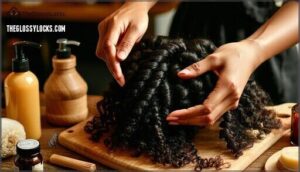This site is supported by our readers. We may earn a commission, at no cost to you, if you purchase through links.

Most people treat post-wash care like an afterthought, tossing on any product and calling it a day. The truth is, wet 4C hair is at its most vulnerable state: the cuticles are open, the strands are fragile, and every move you make either locks in moisture or invites breakage.
Miss this window, and you’ll spend the week battling shrinkage, frizz, and knots. Get it right, though, and you set the foundation for healthy, hydrated hair that actually retains length and moisture between wash days.
Table Of Contents
- Key Takeaways
- What Should You Do After Washing 4C Hair?
- How to Properly Moisturize 4C Hair Post-Wash
- Best Methods to Stretch and Style 4C Hair
- How to Prevent Breakage and Frizz After Washing
- Top Products for Healthy 4C Hair After Washing
- How to Maintain Scalp and Hair Health
- Tips to Keep 4C Hair Moisturized Between Washes
- Frequently Asked Questions (FAQs)
- Conclusion
Key Takeaways
- The first 30 minutes after washing 4C hair is a critical window where your actions determine whether you’ll have soft, defined curls or a dry, tangled mess—gently blot excess water with a microfiber towel, detangle in sections while damp, and immediately apply leave-in conditioner followed by oils or creams to seal moisture before it escapes.
- Preventing breakage and frizz requires minimizing manipulation after washing, switching to satin or silk pillowcases to eliminate moisture-stealing friction, and choosing low-manipulation protective styles like two-strand twists or braids that keep your strands bundled and safe between washes.
- Stretching 4C hair without heat damage is achievable through techniques like twisting or braiding while damp, banding, or Bantu knots—but if you need speed and reach for a blow dryer, always armor up first with heat protectant and use low-to-medium settings with a diffuser attachment.
- Maintaining moisture between washes isn’t guesswork—refresh curls every 2-3 days with a water and leave-in mix, protect your hair at night with silk or satin, and stay flexible by adjusting your routine based on how your strands respond rather than forcing a rigid schedule.
What Should You Do After Washing 4C Hair?
Once your 4C hair is freshly washed, what you do next makes all the difference in keeping those coils healthy and manageable. The key is managing your hair with care while it’s still damp and vulnerable.
Here’s what you need to focus on first.
Gently Remove Excess Water With Microfiber Towel
The seconds after rinsing are make-or-break for 4C hair—one wrong move with a regular towel can undo all the care you just put into washing. Instead, reach for a microfiber towel or even an old cotton t-shirt.
These materials absorb moisture without roughing up your hair’s delicate cuticle, which means reduced frizz and less breakage. Gently squeeze—don’t rub—working from roots to ends to blot away excess water while keeping those precious hair pores closed.
Detangle Hair in Sections
Once that water’s blotted out, it’s time to tackle what scares most 4C naturals—detangling—but here’s the secret: working in small, manageable sections transforms this from a dreaded chore into a breakage-free breeze.
Here’s your sectional detangling blueprint:
- Divide damp hair into 4-6 workable sections using clips
- Apply leave-in conditioner with slip for gentle combing
- Start detangling from ends, working up to roots
- Use wide-tooth combs or fingers for tangle removal
This hair segmenting approach protects your strands while keeping moisture locked in.
Avoid Rubbing or Rough Handling
Your delicate detangling work means nothing if you turn around and mistreat those fragile strands with aggressive rubbing or harsh towel friction. Think of your 4C hair like silk—it demands Soft Hair Management and Minimal Manipulation to protect against hair breakage.
This Fragile Hair Care approach preserves your hair health through Gentle Towel Use.
| Damaging Action | Smart Alternative |
|---|---|
| Vigorous towel rubbing | Pat and squeeze gently |
| Harsh back-and-forth motion | Blot in downward strokes |
| Regular terry cloth towels | Microfiber or cotton t-shirts |
| Aggressive squeezing | Light compression only |
| Rushed drying techniques | Patient, gentle methods |
This hair management shift protects your Delicate Detangling efforts while supporting proper hair moisturizing—essential hair care tips for thriving 4C strands.
How to Properly Moisturize 4C Hair Post-Wash
Moisturizing 4C hair right after washing isn’t just a step—it’s your main defense against breakage and shrinkage. The key is locking in water while your strands are still damp, creating a moisture barrier that lasts.
Here’s how to do it the right way.
Apply a Leave-in Conditioner
Think of leave-in conditioner as the foundation your 4C hair has been craving—it’s what stands between a day of soft, manageable coils and one spent battling dryness and tangles.
Work it through damp hair in small sections, focusing on strands rather than your scalp. Choose formulas that match your hair porosity—lightweight for low porosity, creamier for high.
This step locks in moisture and preps your coils for whatever product layering comes next.
Layer Oils or Creams to Seal Moisture
Sealing is where the magic happens—without it, all that moisture you just layered in will evaporate before you finish styling. Use lightweight oils like jojoba or grapeseed for low porosity hair, heavier butters like shea for high porosity. Apply using the praying hands method, then scrunch gently. This hydration technique locks everything in place.
- Layer oil over your leave-in while hair’s still damp for maximum moisture locking
- Mix cream with oil in your palms before applying—oil blending boosts penetration
- Use the praying hands method for smooth cream application without disturbing your curl pattern
- Focus sealant methods on mid-lengths and ends where hair dries fastest
- Less is more—start light, you can always add more for better hair sealing
Focus on Ends and Dry Areas
The ends of your hair are the oldest, most weathered parts—they’ve survived months of manipulation, styling, and friction, making them the first to cry out for extra attention. These fragile tips need deep conditioning and concentrated hair moisturizing to fight breakage prevention.
Apply extra leave-in conditioner and oil directly to ends for proper hair sealing, guaranteeing complete hair hydration where moisture escapes fastest and dry area care matters most.
Best Methods to Stretch and Style 4C Hair
Once your hair is moisturized, you’ll want to stretch it to show off length and reduce tangling. The right stretching method can make a huge difference in how your curls behave throughout the week.
Here are three tried-and-true techniques that protect your strands while giving you the results you’re after.
Twisting or Braiding While Damp
When your 4C hair is still damp and pliable, twisting or braiding becomes one of your most powerful tools for stretching curls and locking in moisture.
Section your hair into manageable parts, then apply your leave-in before creating two-strand twists or small braids. These techniques reduce shrinkage while defining your natural texture.
Let them air-dry completely for gorgeous twist-outs that protect your strands from excessive manipulation.
Banding and Bantu Knots
If you want serious stretch without heat, banding and Bantu knots deliver length and definition that’ll have you wondering why you didn’t try them sooner.
Hair banding uses elastic bands down each section to gently elongate strands, while Bantu knots create stunning coiled twist outs when unraveled.
Both protective styles work beautifully on damp 4C hair, stretching your natural texture while minimizing breakage.
Using a Blow Dryer With Heat Protectant
Heat is your shortcut when time won’t wait, but only if you armor up first with the right protectant. Blow dryer settings matter just as much as the protectant products you choose—your 4C hair health depends on both working together to prevent thermal damage during hair straightening.
Here’s your heat styling tips checklist:
- Apply heat protectant to damp sections before hair drying
- Use low-to-medium heat with a diffuser attachment
- Keep the dryer moving to avoid concentrated heat spots
- Tension-dry with a paddle brush for maximum stretch
Smart hair care means protecting your strands while achieving the style you want.
How to Prevent Breakage and Frizz After Washing
You’ve put in the work to wash and moisturize your 4C hair—now it’s time to lock in that progress. The real challenge isn’t just getting your hair clean, it’s keeping it strong and smooth once you’re done.
Here’s how to protect your strands from unnecessary stress and keep frizz at bay.
Minimize Manipulation and Combing
Every time you touch your freshly washed 4C hair, you’re rolling the dice on breakage—and the house always wins when you keep reaching for that comb. Once you’ve finished detangling in the shower, put down the tools and step away.
Your hair needs time to set without constant fussing. Light manipulation prevents tangles from reforming while reducing stress on fragile strands that are already vulnerable when damp.
Use Satin or Silk Scarves/Pillowcases
Cotton pillowcases are secretly sabotaging all the effort you just put into washing and moisturizing your hair—they create friction that roughens cuticles and wicks away moisture while you sleep. Switch to satin or silk for immediate friction reduction and better hair slippage.
Here’s why fabric choices matter for 4C hair:
- Satin scarves lock in moisture overnight without stripping oils from your scalp
- Silk benefits include smoother cuticles and fewer tangles by morning
- Cotton absorbs up to 30% of your leave-in products during sleep
- Protective fabrics preserve your hair care routine’s results between washes
Protect Hair With Low-Manipulation Styles
Beyond swapping your pillowcase, your styling choices play an equally powerful role in keeping breakage at bay. Low-manipulation styles work as armor for 4C hair by minimizing touching, combing, and tension between washes.
Think protective styles like two-strand twists, chunky braids, or flat twists that keep your strands bundled and safe. Soft treatment is key—you’re giving your curly hair management a break while locking in moisture. Hair twisting and braid styles aren’t just cute; they’re strategic protection that lets your hair breathe without constant interference.
Top Products for Healthy 4C Hair After Washing
The right products make all the difference when caring for 4C hair after washing. Choosing formulas and tools that work with your hair’s unique needs helps lock in moisture and prevent damage.
Let’s look at the essentials that’ll keep your 4C hair thriving between wash days.
Moisturizing Leave-Ins and Creams
Your leave-in conditioner is your first line of defense against dryness. Products containing humectants like glycerin and aloe vera attract moisture deep into your strands, boosting retention by up to 30%. Look for formulas with fatty alcohols and shea butter—these ingredients smooth the cuticle while reducing breakage by an average of 44%.
Apply to damp hair in sections for maximum absorption and long-lasting hydration. To maintain healthy 4C hair, consider using techniques for moisture retention methods.
Natural Oils and Butters
Sealing moisture with oils and butters keeps your curls thriving. Coconut oil cuts protein loss by 33% when used as a pre-poo, while shea butter—used by over 82% of 4C hair enthusiasts—locks in hydration for up to five days.
Warm cocoa or cupuacu butter between your palms before applying to damp ends, boosting absorption by 40%. These natural emollients strengthen strands and reduce breakage by 22% when layered post-wash.
Using the right hair care products can make a significant difference in the health and appearance of 4C hair.
Recommended Tools for Gentle Styling
The right tools turn wash day from a wrestling match into a ritual your strands actually look forward to. Swap friction for finesse with these essentials:
- Wide-Tooth Comb: Glides through damp sections without snagging
- Detangling Brushes: Flexible bristles navigate coils gently
- Microfiber Towel: Absorbs water without roughing up cuticles
- Silk Scarves: Lock in moisture overnight
- Gentle Clips: Section hair without creasing or tension
Pair your wide-tooth comb with a leave-in conditioner for slip, then wrap in a satin cap to protect your work.
How to Maintain Scalp and Hair Health
Your hair is clean, but your scalp needs attention too. A healthy scalp is the foundation for strong, thriving 4C hair, and maintaining it doesn’t have to be complicated.
Here’s how to keep both your scalp and strands in top shape between washes.
Massage Scalp for Circulation
Your scalp deserves just as much attention as your strands. A good massage after washing doesn’t just feel incredible—it actually wakes up blood flow that brings nutrients straight to your hair follicles.
Use your fingertips—not nails—to work in small circles across your entire scalp for about three to five minutes. This circulation technique encourages hair growth while promoting scalp health and giving you a moment of pure relaxation.
Check for Product Buildup or Dryness
Even after a seemingly perfect wash day, hidden culprits can sabotage your hair’s health—buildup and dryness often lurk beneath the surface, quietly undermining all your hard work.
Run your fingers along your strands and scalp—does your hair feel coated or squeaky? That’s product buildup messing with your hair porosity and blocking moisture. If it feels brittle or rough, dryness has set in.
Checking your moisture balance regularly lets you catch these issues before they wreak havoc on your hair hydration.
Clarify Hair Monthly if Needed
Clarifying shampoo isn’t optional—it’s your buildup removal strategy that keeps moisture retention on track. Once a month, sulfate-free clarifying shampoo strips away the residue that clogs your hair porosity and suffocates scalp health.
This deep hair cleansing preps your strands to drink in leave-ins and oils like they’re meant to, boosting clarifying benefits that last. Always follow with deep conditioning to restore what you’ve stripped away.
Tips to Keep 4C Hair Moisturized Between Washes
Keeping 4C hair moisturized between washes isn’t about guessing—it’s about having a game plan that actually works. Your hair will tell you what it needs if you know how to listen and respond.
Here’s how to maintain that moisture you worked so hard to lock in after wash day.
Refresh Curls With Water and Leave-in Mix
Between washes, your curls don’t need a full reset—just a quick wake-up call to bring back their bounce and moisture. Mix water with leave-in conditioner in a spray bottle and lightly mist each section, scrunching as you go. This simple curl refreshing technique restores hydration and curl definition without overwashing.
Here’s your moisture retention game plan:
- Combine equal parts water and leave-in conditioner for ideal hair hydration
- Focus on areas that feel dry or have lost their shape
- Scrunch gently to reactivate your curl pattern
- Seal with a light oil if ends feel parched
- Refresh every 2-3 days to maintain hair moisturizing between wash days
The leave-in benefits extend beyond immediate softness—they create a protective barrier that locks in hydration throughout the week.
Protect Hair at Night
What happens while you sleep can undo every bit of care you put in during the day—friction from cotton pillowcases saps moisture and creates breakage before you even wake up.
Cotton pillowcases quietly sabotage your wash-day efforts, stripping moisture and causing breakage while you sleep
Switch to silk pillowcases or wrap your 4C hair with satin scarves for serious hair protection. These nighttime hair care essentials eliminate friction, lock in moisture, and keep your overnight styling intact.
Gentle wrapping or a loose bonnet transforms sleep into active repair time instead of damage control.
Adjust Routine Based on Hair’s Needs
No two heads of 4C hair react the same way to products or routines—watch how your strands respond and shift your approach when something stops working. Hair density and curl patterns demand flexibility—your 4C hair maintenance thrives when you listen instead of forcing a rigid hair moisturizing schedule.
If breakage prevention becomes an issue, dial back manipulation. When frizz control falters, reassess moisture levels and adjust your hair care routine. Adapt your hair hydration techniques as seasons and needs evolve.
Frequently Asked Questions (FAQs)
What are the consequences of unchecked shrinkage of 4C hair?
Unchecked shrinkage invites tangling, knots, and hair breakage—especially at the ends where 4C hair is most fragile. Without stretching, strands coil tightly on themselves, obscuring curl definition and inviting frizz control battles while accelerating moisture loss and compromising hair elasticity.
How often should you wash 4C hair?
Most 4C hair thrives with washing every 7-14 days, depending on scalp health, hair porosity, and lifestyle.
Listen to your hair—if it feels dry or product buildup accumulates, adjust your wash day schedule accordingly.
Can you skip conditioner after washing 4C hair?
Skipping conditioner after washing 4C hair isn’t wise—your strands desperately need that moisture boost. Conditioner benefits include breakage prevention, improved hair moisture, and better manageability.
Without it, your hair porosity works against you, leaving ends parched and prone to snapping, even if you use leave-in conditioner later.
Should 4C hair be combed wet or dry?
Combing 4C hair dry is like asking for a breakage disaster. Always detangle when damp—not dripping wet—using a wide-tooth comb or your fingers.
Moisture provides slip, reducing snapping and preserving your hair’s delicate structure while preventing unnecessary breakage.
What causes 4C hair to feel dry immediately?
Hygral fatigue from repeated swelling and shrinking during washing strips moisture fast. Porosity issues prevent 4C hair from holding water, causing immediate dryness.
Moisture loss accelerates when you skip sealing products after cleansing, leaving strands vulnerable to breakage.
How long does 4C hair take to dry?
Drying 4C hair is like waiting for a sponge to release water—it clings to every drop.
Depending on hair porosity, density, and drying method, 4C hair texture can take 6 to 12 hours to air dry completely, with high-density or low-porosity strands holding moisture longest.
Conclusion
An ounce of prevention is worth a pound of cure—and nowhere is that truer than with 4C hair. What you do after washing 4C hair doesn’t just affect today’s style; it shapes your hair’s health, length retention, and moisture balance for the entire week.
By protecting those open cuticles, sealing in hydration, and managing your strands with intention, you’re not chasing damage control—you’re building resilience.
Master this window, and your hair rewards you with softness, strength, and definition that lasts.
- https://www.allure.com/gallery/curl-hair-type-guide
- https://www.heycurls.com/blogs/thehue/how-to-care-for-4c-hair
- https://www.byrdie.com/bantu-knots-history-5214601
- https://curlynikki.com/2012/10/the-art-of-pre-poo.html
- https://www.naturallycurly.com/curlreading/healthy-hair/is-it-bad-to-wash-my-natural-hair-everyday










